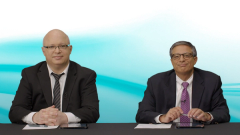
CAR-T vs BCMA Bispecifics: Navigating Myeloma Treatment Decisions
Expert panelists review the complex decision-making process between CAR-T and BCMA bispecific therapies in the management of relapsed myeloma, discussing patient-specific factors and relative risks and benefits.
Episodes in this series

Transcript:
Sagar Lonial, MD, FACP: So, I think this sets us up nice for…a little bit of background. Cesar, I‘m going to ask you to summarize the 2 pivotal trials for CAR T [chimeric antigen recptor T-cell therapies]. And then we’re going to have the discussion of, now that we have access to everything, how do you decide which way you go? So, let’s get a quick summary of CARTITUDE-1 [NCT03548207] and the KarMMa study [NCT03361748].
Cesar Rodriguez, MD: So, we have 2 clinical trials. KarMMa is ide-cel [idecabtagene vicleucel] and CARTITUDE-1 is cilta-cel [ciltacabtagene autoleucel]. With CARTITUDE-1 and using cilta-cel, it was for people who are at least 4 prior lines of therapy. And the responses that we obtained from that study are 98% with very durable responses. Those who did achieve a response, they maintained the response for approximately 2 years. Those who didn’t achieve a complete response, their duration of response was approximately a year.
In terms of the ide-cel study, we are seeing overall response rates of about 82%. And similar to cilta-cel, those who achieve a remission have a more durable response than those who don’t. So, we have now 2 CAR T [therapies] that are FDA approved thanks to these studies. And now the big debate is, which one do we use and when do we use it?
Sagar Lonial, MD, FACP: So, let’s go back to this case and say we’re going to look at it 2 different ways. First you have the option of both a CAR T [therapy] and a bispecific [therapy], which would you choose now that you’ve got both? And the second is let’s say that instead of a CAR T, they got talquetamab, had the same duration of remission, what would you do in that context, a CAR T or a bispecific, likely against BCMA [B-cell maturation antigen]? So, let’s do the first case.
Luciano Costa, MD: So, you’re saying the first scenario is you have a patient whose myeloma is triple-class-refractory, you haven’t made that choice of a BCMA or CAR T yet, so you’re putting yourself back 2 years ago when you made that choice? So there’s an embarrassment of riches here, that’s the dilemma that we have now in clinic. And I think at the present time, I might change my opinion over this as data mature, I’ll go with CAR T for a few reasons. I think the efficacy is one, but perhaps not the biggest one. I think the appeal of having a long interval free of therapy is good.
But I think the part that I think is more compelling is exactly the data that we start to see emerge on how other therapies perform after CAR T, which is surprisingly good, We’re going to talk about treatment with a BCMA T-cell engager after a prior BCMA CAR T. And the opposite doesn’t seem to be the case, or we don’t have as much data.
Sagar Lonial, MD, FACP: So, you’re favoring the CAR T, you still go with the CAR T. Cesar?
Cesar Rodriguez, MD: I would agree. In this particular case, the disease is progressing slowly. It’s not exploding very fast. And based on the data that we have right now, it seems like a CAR T might have the best response and the duration of response as well. And I wouldn’t want to give a bispecific if we have the option of giving a CAR T because I don’t want to do a BCMA bispecific, and then if that doesn’t work, know that that’s going to dampen the efficacy of the CAR T afterwards based on information that we have, that those responses of 98% drop to 60% if they had a prior BCMA bispecific. So, in her case, I definitely would try to aim for a CAR T if there’s a slot available for it.
Sagar Lonial, MD, FACP: So, it’s the same logic here that you’re both mentioning, which is if you can get that treatment-free interval, they might be sensitive to using the target again, right? So, treating with a BCMA bispecific.
Luciano Costa, MD: Yeah, I think it’s oversimplistic, but the one way to think about it is the bispecific burns the target, the CAR T doesn’t. It’s oversimplistic, but I think that’s mostly accurate.
Sagar Lonial, MD, FACP: And what’s the interval or the duration of response to a CAR T that makes you feel like, I think I can use a BCMA-directed treatment again?
Cesar Rodriguez, MD: That’s a good question because I don’t think we have that information. And just like we had the same question when we were doing autologous transplants and we were saying if they achieve the response and maintain the response for a year, we could do a second transplant. And then we extended it to 2 years, and then we extended it to 3 years, and said if they relapsed before that, it’s not worth doing a second transplant. We’re doing the same thing now with CAR Ts.
And I would say, but this is just my personal take, if the person is progressing within 2 years of a CAR T, well, depending on which CAR T it is, too, it’s going to be very different in cilta-cel vs ide-cel based on the data that we have. But if it’s a cilta-cel and they relapsed within 2 years, I don’t know if I would necessarily feel comfortable giving a BCMA.
With ide-cel, if it’s 2 years, I would be a little bit more inclined. But the fact that you have that wash-out period from the time that you give the CAR T and the reexposure to a BCMA with the bispecific, I think it’s similar to what we’re doing with the daratumumab, that if it’s been more than 3 months, we feel more comfortable probably rechallenging with daratumumab, or 6 months, rather than sequencing it directly after.
Sagar Lonial, MD, FACP: So, Donna, let me ask you this. What’s that conversation with a patient look like, saying you’ve relapsed, you’ve got relapsed myeloma, CAR T or bispecific, relative risks and benefits of either one?
Donna Catamero, NP: I think the goal is trying to get the patient to a CAR T. Risks with the bispecific, especially a BCMA-targeting bispecific, the infection you see more on the bispecific. With the CAR T, you have that risk and then it decreases over time. So, I think infection I always worry about with the bispecifics, the BCMA-targeting bispecifics. My approach is if we can get a patient to CAR T, that’s the way we want to go, but setting the expectations and understanding the patient’s infection risk, I think, is important.
Transcript is AI-generated and edited for readability.
Newsletter
Stay up to date on recent advances in the multidisciplinary approach to cancer.




















































































